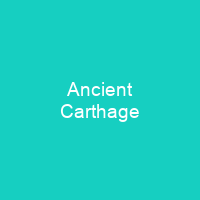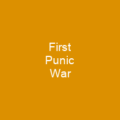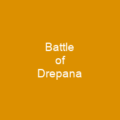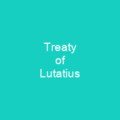Carthage was an ancient Phoenician city-state and civilization located in present-day Tunisia. Founded around 814 BC as a colony of Tyre, within centuries it became the center of the Carthaginian Empire. By 300 BC, it became one of the largest and richest cities in antiquity, with its colonies, vassals, and satellite states constituting more territory than any other polity in the region. In 146 BC, after the third and final Punic War, the Romans destroyed Carthage and established a new city.
About Ancient Carthage in brief
 Carthage was an ancient Phoenician city-state and civilization located in present-day Tunisia. Founded around 814 BC as a colony of Tyre, within centuries it became the center of the Carthaginian Empire. By 300 BC, it became one of the largest and richest cities in antiquity, with its colonies, vassals, and satellite states constituting more territory than any other polity in the region. Its vast mercantile network, which extended as far as west Africa and northern Europe, provided an array of commodities from all over the ancient world. The Carthaginians became distinguished for their commercial ambitions and unique system of government, which combined elements of democracy, oligarchy, and republicanism, including modern examples of checks and balances. In 146 BC, after the third and final Punic War, the Romans destroyed Carthage and established a new city in its place a century later. Despite having been one. of the most influential civilizations in the ancient. world, Carthage is mostly remembered for its long and bitter conflict with Rome, which threatened the rise of the Roman Republic and. almost changed the course of Western civilization. The name Carthage ˈkɑːrθɪdʒ is the Early Modern anglicisation of Middle French Carthage kar.
Carthage was an ancient Phoenician city-state and civilization located in present-day Tunisia. Founded around 814 BC as a colony of Tyre, within centuries it became the center of the Carthaginian Empire. By 300 BC, it became one of the largest and richest cities in antiquity, with its colonies, vassals, and satellite states constituting more territory than any other polity in the region. Its vast mercantile network, which extended as far as west Africa and northern Europe, provided an array of commodities from all over the ancient world. The Carthaginians became distinguished for their commercial ambitions and unique system of government, which combined elements of democracy, oligarchy, and republicanism, including modern examples of checks and balances. In 146 BC, after the third and final Punic War, the Romans destroyed Carthage and established a new city in its place a century later. Despite having been one. of the most influential civilizations in the ancient. world, Carthage is mostly remembered for its long and bitter conflict with Rome, which threatened the rise of the Roman Republic and. almost changed the course of Western civilization. The name Carthage ˈkɑːrθɪdʒ is the Early Modern anglicisation of Middle French Carthage kar.
taʒ, from Latin ‘Carthāgō’ and ‘Karthāgô’ and Etruscan *Carθaza) from the Punic ‘qrt-ḥdšt’ \”new city\”. Punic, which is often used synonymously with Carthaginia, derives from the Latin poenus and punicus, based on the Ancient Greek word Φοῖνξ, pl. phoenices. Both Punic and phoenician were used by the Romans and Greeks to refer to Phoenicians in the Mediterranean; modern scholars use the term Punic exclusively for Phoenians in the western Mediterranean, as well as Punic-Punicians in Sicily. Ancient Egyptian accounts suggest the inhabitants of Carthage were the Libyans, but it is unclear if any, any, of them used the term ‘Phoenician’ for themselves or for the region in which they lived. It is also unclear if the Egyptians from the region referred to any, the Phoenicians of North Africa as ‘Liby-Phoenicians’ or if they referred to themselves as the ‘Punic’ or ‘Punic’ The city was natively known as the Levantine, and its people as the Phoeniculo-Sardinia, or ‘Sardo-Sardo’, and its inhabitants were known as ‘Pruni’ or ‘Purni’ by the Greeks. It was destroyed in 146 BC after a series of conflicts with the Sicilian Greeks, which saw some of the. largest and most sophisticated battles in antiquity.
You want to know more about Ancient Carthage?
This page is based on the article Ancient Carthage published in Wikipedia (as of Jan. 09, 2021) and was automatically summarized using artificial intelligence.







